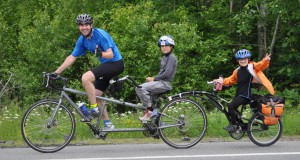Two surprising motivators
Over five years ago my cycling partner and friend Erich contacted me and suggested we should ride in the three-day, 180 mile Trek Across Maine. It seemed like a reasonable and fun challenge, and all for a good cause to fight lung cancer. I was in. Then he added, “We’re taking the boys.”

We rigged up bicycle contraptions featuring a tandem bicycle, plus a “tag-along” (pictured) to accommodate the three of us. The machine, plus the bicycle bags, known as panniers – loaded with rain gear, snacks, water, and probably a few miscellaneous things the kids claimed to need, all weighed in at over 400 pounds with us on board. This was our “triple-bike.”
My mental orientation going into this venture was that it was my job to do the work, and make sure the kids were safe, fed, dry, and hopefully having fun on this expedition. But over sixty miles per day throughout the hills across Maine it became quickly clear that their effort was valuable indeed. While small, when they chose to work and push the pedals over, from my seat I could definitely feel a difference. So while in my mind the journey started on the strength of my efforts alone, It quickly became clear that the difference in not only speed and energy conservation, but also camaraderie and real teamwork, came down to how well we worked as a team to push through hill after hill on these three days.
For example, if approaching a hill, as my son Will was back there throwing water on his brother and generally goofing off, I could say sternly, “If you don’t pedal now, then at the top of this hill I’m going to put you in the Sag wagon and you can ride the rest of the say in the wagon of shame!” (“Sag” is as in “sagging behind”. In events with lots of non-professionals, the sag wagon picks up people who have fallen behind or are dropping out.) And this terse warning might get him to pedal harder for perhaps thirty or sixty seconds. Or inversely, I could urge my son Charlie on by saying, “Buddy, if you pedal really hard we’ll get to the top quicker and I think they are serving ice cream at the next rest stop.” And this might bring about an energetic minute or so of focused pedaling.
Neither negative or positive immediate encouragement yielded any long term motivation. It became clear as the hours went by and the ride went on that there were a number of much more powerful motivators that were much more effective, and fun.
Engaged with other cycling teams
It turned out what I had vastly underestimated – completely overlooked actually – was the importance of doing this journey with Erich and his boys, their friends. They would constantly be aware of where our friends were on the road – either ahead or behind – and we would create ways to interact by riding along side and chatting, or goading each other up the hills. And often we would encounter, and ride, with other participants in the event, which fostered a great sense of communal participation in the event.
Connecting with the Why
After the first year we participated in the Trek Across Maine when the boys were then five and seven years old, I decided they needed a greater and more direct understanding of why we were doing the event. In advance of the next year’s event we rode the triple bike around the neighborhood, and the boys would knock on doors, tell the story about what we were doing, and ask for donations to help fight lung cancer. That active participation in gathering donations for the event connected the boys, and our family, with the deeper reason of why we were participating.
These two small and simple changes in mental orientation – collaborating with others and connecting with purpose – created a powerful sense of engagement in the event, and translated into big pedal power (read: team performance gains).


